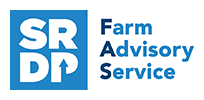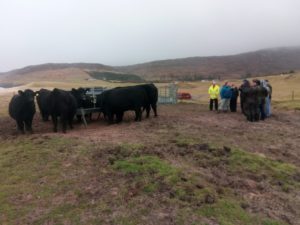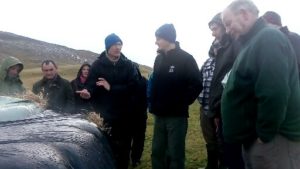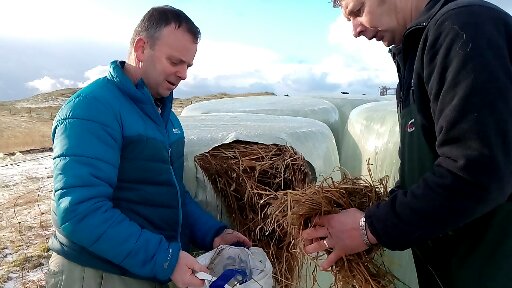Testing Times – Winter Cattle Management (Isle of Harris) – Event summary
4 December 2017Winter Cattle Management
There was a good representation of Harris and Lewis cattle producers who attended the meeting at West Harris Trust hall at Talla-na-Mara. Angus Mackay, who crofts at Scaristavore and on the island of Taransay, kindly allowed a tour of his newly established Aberdeen Angus herd on the machair land at Nisabost giving the specialists and crofters an opportunity to discuss cattle management and nutrition in an open harsh climate.
Nutrition Strategies
Sustaining cattle health can be achieved by good management of the resources available. As feed prices have soared and Gavin Hill, Senior Beef Consultant SAC explained the importance of testing silage and ensuring that animals are been fed a quality diet that meets the animals requirements but takes account of costs and target markets. An arable silage produced on the holding utilising Uist Oats had been sampled as well as balancing this with a new draff supply been produced by the Harris Distillery. Assessment showed how a well produced forage crop and balanced ration could meet the cattle’s requirements on the hill.
Key take home winter feeding points:
- Know your stock – assess their weight and body condition

- Know your feeds – assess the quality and be aware of the animals requirements
- Forward Planning – look to improve home grown forages through new or renewed reseeds and when to crop
Cattle Health Management
Tim Geraghty, SAC Aberdeen Veterinary Centre Manager, engaged the crofters in assessing their health planning and testing. The crofters high health status in the Western Isles is well known and crofters where encouraged to continue to work on focusing to work together to ensure this status is maintained. The utilisation by many groups in the crofting communities of the Scottish Government Bull Stud at Knocknagael offers crofters access to quality genetics with many of the progeny going to Mainland finishers as quality Scottish beef. Discussion focused on strengthening the health testing in the crofting communities, encouraging management an![]() d retention of high health status and to utilise this health status to improve market returns.
d retention of high health status and to utilise this health status to improve market returns.
Handouts from this meeting are available to download below.
Maximising liveweight output from a carefully managed feeding regime can help reduce your farm carbon footprint. Having an efficient system can also lead to better profitability. To read more on how to reduce your carbon outputs or to read what other farmers have done, visit Farming For a Better Climate
- Testing Times event – Industry update presentation slides
- This is a copy of the presentation slides used at the 'Testing Times - Winter Cattle Management' meetings held on the Isles of Harris & Lewis in December 2017
- Topics: Climate Change and Livestock
- Testing times event – ‘Draff as a feed choice’ presentation slides
- These presentation slides look at Draff as a feed choice for winter cattle management. They were used as part of the 'Testing Times - Winter Cattle Mangement' events held on the Isles of Harris & Lewis in December 2017
- Topics: Climate Change and Livestock
- Draff – a feed specification sheet
- This is a feed information sheet about Draff as an animal feed
- Topics: Climate Change, Livestock and Crops and Soils
- Practical Guide: Improving Shed Ventilation for the Beef Herd
- This practical guide looks at maximising performance of housed beef cattle by improving ventilation in buildings.
- Topics: Climate Change
- Practical Guide: Silage Testing: Interpreting the Results
- This practical guide looks at helping to maximise performance of housed cattle by improving the use of silages.
- Topics: Climate Change
- Carbon Footprinting in the Beef Herd
- Carbon Footprinting in the Beef Herd: A practical guide
- Technical Note (TN634): Ensuring Good Welfare of Outwintered Cattle
- Technical Note (TN677): Treatment and Control of Liver Fluke in Sheep and Cattle
- The number of disease outbreaks due to the liver fluke Fasciola hepatica has increased in recent years with unprecedented numbers of sheep affected in 2012/13.
- Topics: Livestock
- QMS Guide to improving suckler herd fertility
- Managing and improving the fertility of your suckler herd is one of the key ways to improve cow margins and hence business profitability. This booklet from QMS is designed to help you assess your herd’s fertility and identify scope for improvement, and provides ideas you can put into practice on your farm.
Sign up to the FAS newsletter
Receive updates on news, events and publications from Scotland’s Farm Advisory Service



